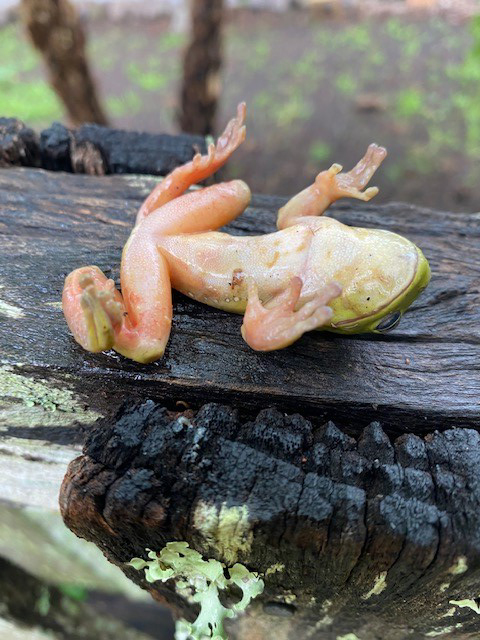Spate of frog deaths has scientists worried
Categories
Share
Southern Cross University frog researchers are concerned by reports of a disturbing number of sick, dying or deceased frogs across eastern Australia.
The mass mortality event in Queensland, New South Wales and Victoria may be an indicator of a known fungal pathogen or worse, a new strain.
“Reports are coming in of multiple frogs being found shrivelled and turning brown on people’s lawns,” said Southern Cross University’s Dr David Newell, a biologist with a focus on amphibian diversity, ecology and conservation.
“It’s unusual to see dead frogs because most frogs are secretive in nature and decompose rapidly out of sight when they die. So when there are multiple reports like this happening, we get very worried.”
The most commonly observed sick or dead amphibian is the green tree frog (Litoria caruelea) however a range of other species also appear to be susceptible.
A fungal pathogen called the amphibian chytrid fungus is the most likely cause of the current deaths, but scientists want to be certain and are calling on the community to help monitor the situation.
“Just like we have seen with COVID-19, it is possible that a new strain of the chytrid fungus has emerged and we need to investigate this,” said Dr Newell who has been studying amphibians for 25 years.
“We know that the fungus thrives in cold and wet conditions. This has been the focus of research at Southern Cross University over a number of years now with the support of the NSW Government’s Saving Our Species Program.
“Australia’s frogs face a range of threats including habitat loss, climate change, pollution and disease, with 35 of our 242 species now considered threatened.
“At least four species have gone extinct since the early 1980s and globally there are more than 500 species that are facing extinction.”

A dead green tree frog (credit Patricia Packham).
How you can help
FrogID, a national citizen science program run by the Australian Museum, is seeking to collate reports from members of the community.
“If you find dead frogs, please take a photo and record the location details and send this information via email to calls@frogid.net.au,” said Dr Newell.
Scientists are also seeking specimens. If you find a freshly dead frog, collect it in a snap-lock bag and record the location, your contact details, the date and place it in a freezer for collection. Then email FrogID via calls@frogid.net.au
You can also arrange to drop off dead frog specimens locally by contacting Dr Newell via email david.newell@scu.edu.au
For sick frogs, seek immediate help
If you find a sick frog, take it immediately to a wildlife veterinarian and ask them to contact the Australian Registry of Wildlife Health for treatment protocols.
For those on the NSW Far North Coast, the Byron Bay Wildlife Hospital is on board with this initiative and are set-up to help out with sick frogs locally. Call the Byron Bay Wildlife Hospital on +61 437 818 883.
Media contact: Sharlene King, media office at Southern Cross University, 0429 661 349 or scumedia@scu.edu.au

/prod01/channel_8/media/scu-dep/current-students/images/Coffs-harbour_student-group_20220616_33-147kb.jpg)
/prod01/channel_8/media/scu-dep/current-students/services/counselling/images/RS21533_English-College-Student_20191210_DSC_6961-117kb.jpg)
/prod01/channel_8/media/scu-dep/study/scholarships/images/STEPHANIE-PORTO-108-2-169kb.jpg)
/prod01/channel_8/media/scu-dep/study/arts-and-humanities/images/RS20958_Chin-Yung-Pang-Andy_20190309__79I5562-960X540.jpg)
/prod01/channel_8/media/scu-dep/experience/images/SCU-INTNL-STUDY-GUIDE-280422-256-72kb.jpg)
/prod01/channel_8/media/dep-site-assets/component-library/screenshots/online-1X1.jpg)
/342x0:1220x878/prod01/channel_8/media/scu-dep/news/images/2025/Amy.jpg)
/540x0:1460x920/prod01/channel_8/media/scu-dep/news/images/2025/Georgina-Dimopoulos-SCU-COUNCIL-HEADSHOTS-17042025-133_2000px.jpg)
/514x0:1487x973/prod01/channel_8/media/scu-dep/news/images/2025/Kindergarten-children_credit-Pixabay-on-Pexels-159823-2000X973.jpg)
/514x0:1487x973/prod01/channel_8/media/scu-dep/news/images/2025/Coral-larvae-seedbox-dye-Credit-G-Carlin_CSIRO-2000X973.JPG)
/514x0:1487x973/prod01/channel_8/media/scu-dep/news/images/2025/Soft-drink-with-ice_credit-Towfiqu-Barbhuiya-on-Pexels-3440682-11477545-2000X973.jpg)
/484x0:1516x1032/prod01/channel_8/media/scu-dep/news/images/2025/esports-2.jpg)
/484x0:1516x1032/prod01/channel_8/media/scu-dep/news/images/2025/ai.jpg)
/514x0:1487x973/prod01/channel_8/media/scu-dep/news/images/2025/HEART-logo-2000X973.jpg)
/514x0:1487x973/prod01/channel_8/media/scu-dep/news/images/2025/Watermelon-slices_credit-Any-Lane-on-Pexels-5946081-2000X973.jpg)
/484x0:1516x1032/prod01/channel_8/media/scu-dep/news/images/2025/JN_01474-AllWinners-2000X1032.jpg)